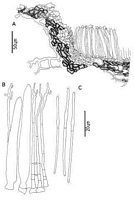|
 Marthamyces dendrobii Marthamyces dendrobii
SynonymsPropolis dendrobii
BiostatusPresent in region - Indigenous. Endemic
Images (click to enlarge)
Caption: Fig. 17. Propolis dendrobii: A, ascocarp margin in cross-section. B, asci and paraphyses, C,
released ascospores. | 
Caption: Fig. 31 Macroscopic appearance of ascocarp (x 12). Propolis dendrobii |
Article: Johnston, P.R. (1986). Rhytismataceae in New Zealand. 1. Some foliicolous species of Coccomyces de Notaris and Propolis (Fries) Corda. New Zealand Journal of Botany 24(1): 89-124 (http://www.rsnz.org/publish/abstracts.php).
Description: Ascocarps develop on upper and lower surfaces o fallen leaves, within pale brown lesions.
Ascocarps round in outline, 0.3-0.5 mm diam. Immature ascocarps have the appearance of
small, darkened pustules on the leaf. They open by four radiate slits, with the covering host
and fungal tissue folding back to expose the grey, pruinose hymenium.
Ascocarps intraepidermal to subepidermal. In vertical section upper wall up to 50 µm wide,
comprising a 20-30 µm wide layer of dark brown, thick walled, hyphal cells, 5-12 µm
diam. Inner layer of wall lined by a 10-20 µm wide layer of crystals. A layer of periphyses,
10-15 x 2-3 µm, forms on the inside of the lower part of the wall. Lower wall 15-30 µm
wide, similar in structure to the upper wall, with some hyphae extending below the wall layer
amongst the host hypodermal cells. Subhymenium 5-8 µm wide, of hyaline, thin walled,
more or less globose cells.
Paraphyses 1-2 µm diam., irregularly swollen and branching near the apices, capped by
scattered clumps or crystals, not extending beyond asci. Asci cylindric or wider toward the
base, narrowing abruptly to a short, basal foot, tapering gradually to the rounded apex, 71-76
X 5.5-6.5 pm (up to 8- 1 0 pm wide near the base), uniformly thin walled, non-amyloid, 8-spored. Ascospores filiform, 51-67 x 1-1.5 µm, 1-septate, with a small swelling (up to 2
µm diam.) above the septum, gelatinous cap at both ends.
Habitat: Fallen leaves of Dendrobium cunninghammii.
Notes: ETYMOLOGY: dendrobii; refers to host plant.
NOTES: Distinguished from P. emarginata, the other dark walled Propolis species found in
New Zealand, by ascospore shape.
|